
Background information
Walking under the microscope: gait analysis in the movement laboratory
by Michael Restin

I want to improve my understanding of the human gait. And to do so, I need to delve into detail. In this interview, I chat to Professor of Sports Medicine, Dr Johannes Scherr about some anatomy basics, collapsed midfeet and the fact that sneakers aren’t for running.
I rarely give my feet a second thought. Today, however, they’ve brought me to the Center for Prevention and Sports Medicine at Balgrist University Hospital, where they’ll be the centre of attention. It’s here that I meet Head Physician Dr Johannes Scherr. The sports physician is very nice, answering even my seemingly obvious foot-related questions. Since I want to gradually improve my understanding of the human walk, and need to start somewhere, I’m starting right at the bottom of the body. And right at the beginning.

In the run-up to our conversation, I was flicking through some anatomy books and it dawned on me how little I know about the foot. Can its structure be summed up in simple terms?
Professor Johannes Scherr: I’ll give it a go. We have, from front to back: the toes, the metatarsus, the tarsal bones and the two weight-bearing elements at the heel – the calcaneus and talus. In plain English, those last two are the heel bone and ankle bone. After that, we have the bridge towards the tibia and fibula – they’re the inner and outer bones in your lower leg, which, together with the talus, form the ankle joint.
Many things are more understandable when you can physically see them, so Scherr has brought along a model. He bends and stretches, shows and tells. Os naviculare. Os cuboideum. Tarsometatarsal joints. Our feet may not be the largest of body parts, but together they contain roughly 25 per cent of all our bones. That’s 26 bones in each. Plus the two knobbly sesamoid bones embedded in the short flexor tendons of the big toes. These bones act as a fulcrum (linked article in German), creating more leverage for the muscles. 33 joints, 20 muscles and 114 ligaments ensure a complex interplay at every step, which continues seamlessly upwards via the ankle joint – the point Scherr has already reached in his explanation.
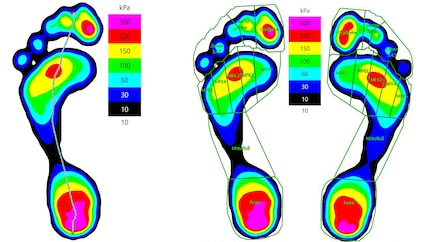
At the end of the day, our feet have to support our entire body weight. How is this weight distributed when we’re standing?
The main weight-bearing points are the sesamoid bones under the first metatarsal head, the point above the metatarsophalangeal joint of the little toe and the heel.
And what happens when we walk or run?
We’re able to look at that through pedobarography. You know, the foot pressure measurement we took from you as part of your gait analysis. This allows you to see the pressure distribution as well as the main weight-bearing points. If you walk normally, your back foot hits the floor first and then your step rolls off your midfoot. This tends to take place across the outer edge of the foot. The last part of your step involves pushing off from your front foot. You mostly use your big toe and second toe for this. The big toe is especially important for walking as it creates stability.

That’s how a healthy foot works. How are the arches designed to distribute your weight properly and ensure that the foot isn’t sitting flat on the floor?
There are the longitudinal and the transverse arches, which are tightened by tendons, ligaments and muscles. Though, as far as the longitudinal arch is concerned, these are only partly on the foot itself. That’s home, for example, to the short foot muscles, the plantar tendon plate and the long sole ligament. Others are housed on the lower leg.
What would those others be?
When pressure is placed on the foot, the tibialis posterior tendon on the back of the posterior tibial muscle supports the medial longitudinal arch. The big toe flexor, or musculus flexor hallucis longus, and the long toe flexor, or musculus flexor digitorum longus, also start in the lower leg. They form part of the lower calf muscles.
We humans take our first steps on flat feet after about a year. How do our feet go on to develop?
The foot should be fully developed by age 11 or 12. Although, it depends on the kind of pressure it’s subjected to. After all, the longitudinal and transverse arches are also tightened via muscles. The more they’re trained, the earlier they take shape.
How strong are the forces at work when we’re walking and running?
The skeletal system isn’t the only deciding factor here. The tendons, which ultimately work in the same way as springs, come into play, too. It depends how fast you walk and how well cushioned your foot is.
I can roll over my heel, touch down with my midfoot or walk on my forefoot. What difference does running technique make?
Basically, the same forces are in effect. Regardless of whether you run on the back or front of your foot: momentum is mass times velocity. Sometimes you have the momentum at your heel at the back, sometimes it’s at the front. Since the surface area of the back foot is smaller, you have higher peaks in pressure than when walking on your forefoot. But the momentum at the level of the ankle joint remains constant. You need to absorb energy from somewhere.
The energy transferred by contact with the ground or floor.
The vertical speed at which your foot strikes the floor is known as the impact. If you’re a sprinter or if you’re jumping, the impact will be greater. When it comes to joggers, you often see them floating along, merely pushing their feet forwards, barely lifting them. In other words, there’s a lot of horizonal movement and hardly any vertical movement. In this case, the impact is reduced.
In the video below, you can see what happens when the foot of a top athlete hits the ground. In sprinters, extreme peaks in force occur within 100 milliseconds. Ground reaction forces equivalent to up to five times their body weight, in fact. In world-class marathon runners, the curve is flatter, with longer contact times. Over their running distance, they absorb triple their body weight 25,000 times.
Even healthy feet get tired eventually. Is it possible to literally run them flat?
On the one hand, your feet swell over the course of the day. This is down to the hydrostatic pressure exerted on them from above by the venous system. But the foot muscles, which tense the transverse and longitudinal arches eventually get tired, too. Then the arches flatten, making the foot wider and longer. You see this, for example, in runners who’ve completed a marathon in four hours. Or runners who trail over the finish line with the sweeper bus after six hours.
So does that mean people who’ve just taken up running will develop issues with their feet earlier?
Novice runners might not necessarily have problems in the future. It depends on the stability of the foot. It can certainly happen to people who sit in front of a screen all day and haven’t had any strain on their feet for a long time. In this case, I’d recommend gradual increases as well as starting foot stability exercises that you can do while sitting down.
So the feet aren’t necessarily the first parts of the body to give up the ghost.
Usually, it’s the entire chain of movement. Everything’s related and begins, for example, with a midfoot collapse. This causes the knee to rotate inward, which may eventually lead to problems with the hips or spine.
Running involves team work between different body parts. If one is weakened, the others have to compensate. The process often comes creeping in – and it’s so individual that the whole system has to be considered when investigating the causes. It all depends on the interplay.
The first foot ailments I can think of are flat foot, skew foot and splay foot. Are these the most common problems?
Nein, nicht direkt. These terms would describe malformations. However, if you look at complaints of the lower extremity, for example, many patients and athletes come to us with a midfoot collapse. If we’re talking about medically relevant complaints, bunions are the most common. In this case, there’s a varus malalignment of the first metatarsal. On the inner edge of the foot, the head of the bone protrudes very obviously. This might be down to your footwear or stress on the foot. On the other hand, bone deformities are often inherited, too.
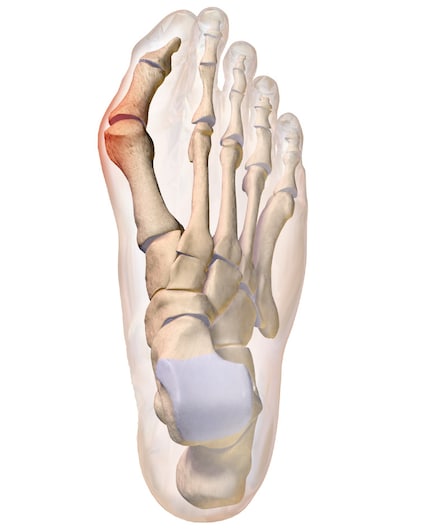
So I’m not always able to prevent stuff like that through exercise.
Exactly. You can also just be unlucky. To a certain extent, exercising is helpful. If it’s not possible to do that anymore, the bone can be corrected surgically. Women are affected by this more often. Being overweight or wearing unsuitable footwear – think too-high heels, shoes that are very narrow at the toes, or shoes that are too small – are seen as risk factors.
Are women more frequently affected by other foot complaints too?
Pes planovalgus or flat feet are three times more common in women. This has to do with anatomical differences and begins all the way up in the hips. The pelvis is wider and slightly tilted. By way of the thigh bones, this impacts the knees, often leading to knock knees. As a result, the lower leg causes the formation of a skew foot more often.
Lack of exercise, strain and bad footwear are high up on Dr Google’s list of causes of foot issues.
If you don’t move enough and the foot isn’t put to use, the muscles obviously begin to waste away: inactivity atrophy. When I put my feet up, they don’t even need to hold my standing weight. So, it’s clear that they’ll keep getting weaker.
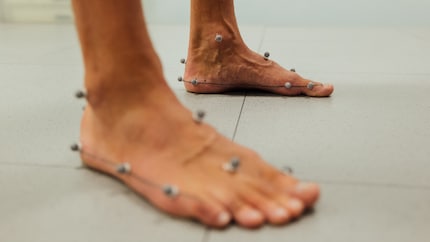
And how do I avoid doing the opposite – over-straining them while running?
That depends. I’m not a fan of huge pronation supports. Some people need them – especially when they’re just starting out as runners. But the foot rests on passive supports or insoles and thinks: «Great, now I don’t have to do any work.» That way, it stays or becomes inactive and the muscles don’t get stronger. In that case, you should do the appropriate training.
Which would be...?
If you go for a 40-minute run and don’t have any major foot deformities, you should try that in normal shoes. After all, youdon’t necessarily need insoles for day-to-day stuff like nipping to the shops. On the other hand, if you go on a 10-hour shopping spree in Paris or run a marathon, you’ll eventually need a support because your muscles will tire out. If you have a foot deformity before you even put weight on your feet, a doctor should decide if and when you should wear a pronation support.
It’s not just the foot that tires out. The material eventually does, too. Will my beat-up favourite shoes become a problem for me when doing sport? Do I need different kinds of shoes as an occasional jogger?
Having the right shoes is hugely important. There, I’d say: it’s better to have a well-fitting pair that’s replaced on time than to be experimental. And it’s not the case that expensive shoes are necessarily better.
What kind of shoes shouldn’t be touched with a barge pole?
You’ve got to watch out when it comes to sneakers. They’re meant for looking trendy and aren’t appropriate for sport. Every major sporting goods manufacturer carries shoes that are only partly suitable for running. Sneakers aren’t running shoes, which guide the foot into their natural movement and provide a bit of midfoot support. In any case, running shoes in themselves are a hotly discussed topic.
One thing is clear: it’s best to have healthy feet. So, the next step of this journey will be about how to treat them well. I’ll be heading to running school with the physiotherapist and track and field athlete Pascale Gränicher. On top of that, I’ll find out that during foot exercises, even the smallest of movements can pose big challenges.
Simple writer and dad of two who likes to be on the move, wading through everyday family life. Juggling several balls, I'll occasionally drop one. It could be a ball, or a remark. Or both.
Interesting facts about products, behind-the-scenes looks at manufacturers and deep-dives on interesting people.
Show all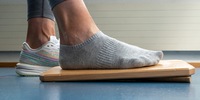
Background information
by Michael Restin

Background information
by Siri Schubert
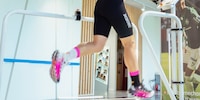
Background information
by Siri Schubert